Entrepreneurs
Women Trailblazers: The Most Successful Female Founder in Every Country

If you are a female entrepreneur, it’s natural to feel like the odds are against you. After all, there continues to be a significant bias towards a male-leadership model, and investors still tend to be more cautious in their response to pitches from women.
You shouldn’t be put off by nay-sayers, though. If you’ve got a great business idea, it’s really worth persevering to make it happen. Despite the fact that only 15% of venture capital is invested in them, women-led businesses consistently offer a better return on that investment.
Women entrepreneurs out-perform their male counterparts in terms of revenue, in part because their motivations tend to be less profit-driven. With a more meaningful, customer led approach, greater interest in corporate social responsibility, and collaborative working culture, they are primed for greater overall success.
To celebrate the impressive achievements of women who are world leaders in startup business, BusinessFinancing have gathered data on the top female founders from country to country around the world.
Top 5 Women Startup Founders Around the World
The data shows that startup success is possible across a wide range of industries, with particular success in fintech and e-commerce. The self-made women with the highest levels of finance are spread across the continents. Lucy Peng’s online finance company Ant, which is based in China, has achieved a massive $22 billion in funding. No wonder she was named Forbes’ 35th most-powerful woman in 2016.
Hot on Peng’s heels is Rebekah Neumann, whose US-based real-estate company The We Company, which specialises in establishing collaborative work spaces, achieved a significant $19.5 billion. With the third highest funding of $9.9 billion, Singapore’s Tan Hooi Ling has revolutionised transportation with her Grab app, which connects drivers and passengers.
Innovating fintech to offer more personal finance services to smaller businesses, and creating a fairer personal lending platform, Kate Keenan (Judo Bank – Australia) and Victoria van Lennep (Lendable – UK) achieved similar funding levels of $1.4 and $1.2 billion, respectively.
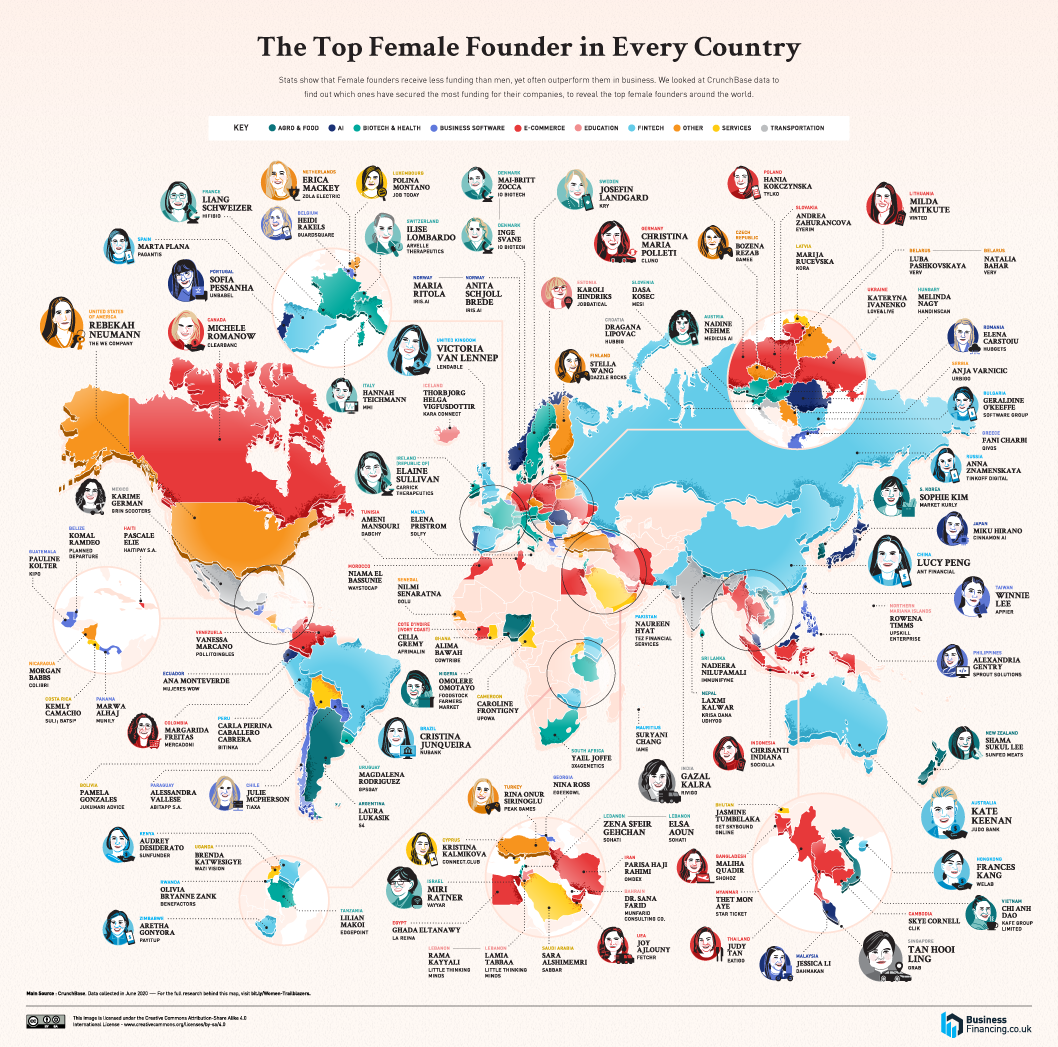
Top Women Founders in Europe
In addition to Victoria van Lennep’s huge success in fintech with Lendable, the biotech and health industry is a thriving field for startups in Europe. Switzerland’s Ilise Lombardo has raised a $278 million fortune for the biopharmaceutical company Arvelle Therapeutics, specialising in treatments for disorders of the Central Nervous System (CNS). In Sweden also, Josefin Langerd got $348 million for KRY’s healthcare and digital health services.
Lifestyle systems and wellness are flourishing fields for women entrepreneurs in eastern europe. Anja Varnicic raised an impressive $127,054 for her mini indoor garden enterprise in Serbia, and Belarussians Luba Pahkovskaya and Natalia Bahar each raised $265,000 each for their wellness and fitness app, Verv.
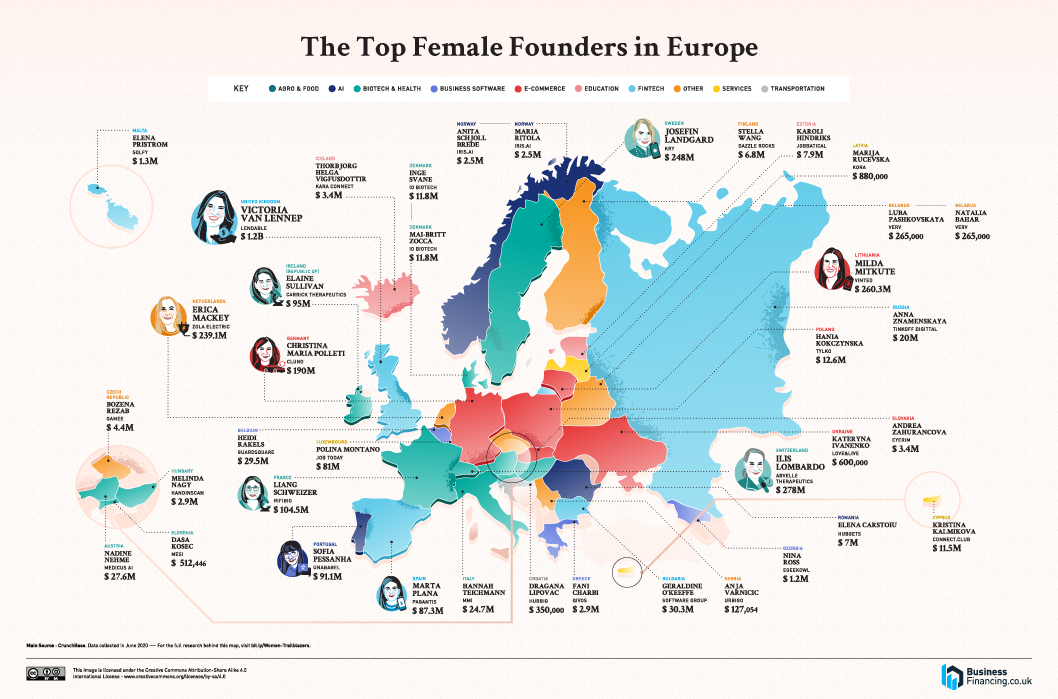
Top Women Founders in North America
Women are making it big with e-commerce and business software in North AMerica. After Rebekah Neuman, Canada’s Michelle Romanov has raised $119.2 million for Clearbanc. The data also shows that community-focused startups are financially viable, with $100,000 raised by Marwa Alhaj in Panama for her security and communications software company, and $130,00 by Morgan Babbs, who is making a difference to low income houses with her solar solutions company, Colibri, in Nicaragua.
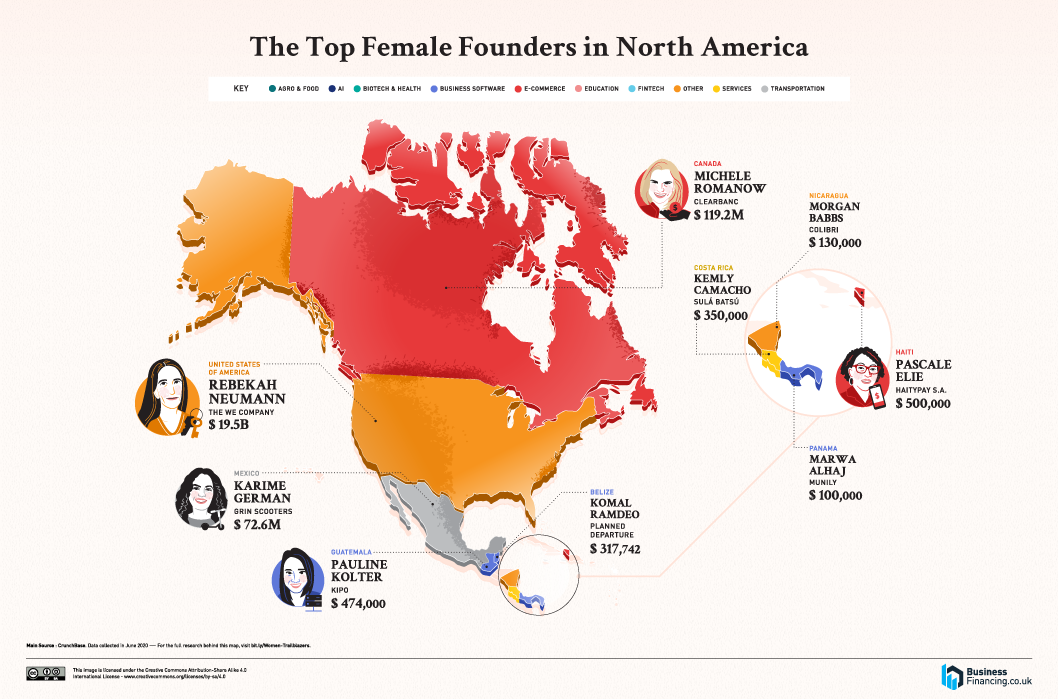
Top Women Founders in South America
Brazil’s Cristina Junqueira is pretty inspirational. Not only did she raise $1.1 billion for her finance company, Nubank, but she is also a vocal advocate for gender equality and inclusion in the world of business and finance. She clearly understands the benefit of being forward-thinking and how embracing diversity will attract new talent. No wonder she was listed twice as one of Forbes’ most powerful women!
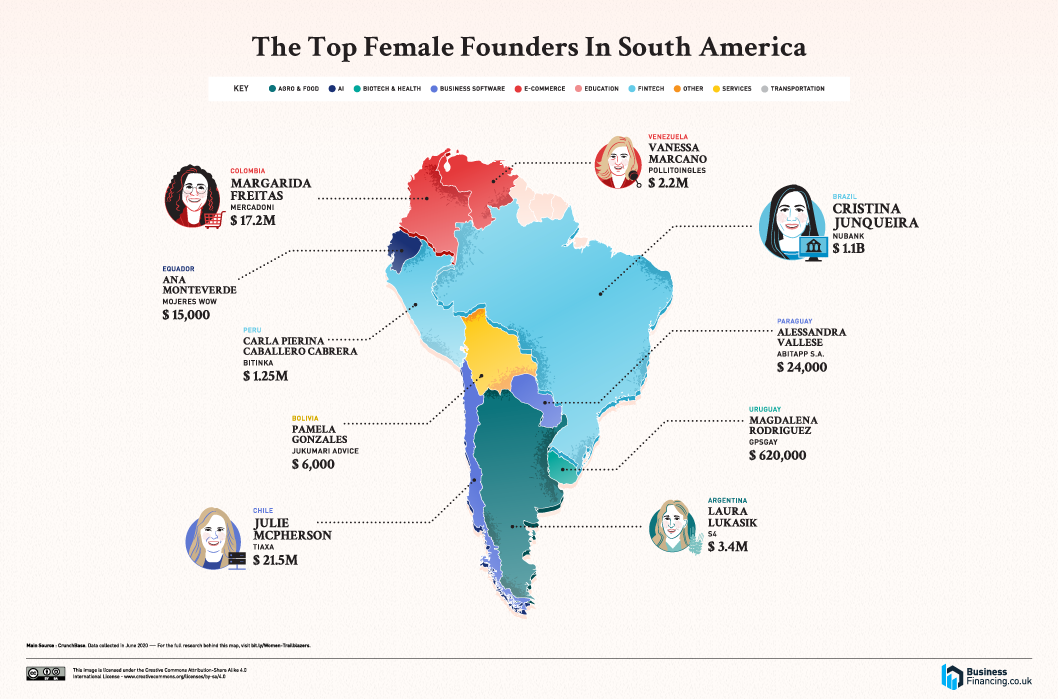
Top Women Founders in the Middle East & Central Asia
There’s a lot going on for women entrepreneurs in this part of the world, with start up founders doing well in the fields of education (Lamia Tabbaa and Rami Kayyali at Little Thinking Minds in Jordan) and gaming (Rina Onur Sirinoglu at Peak Games in Turkey), as well as the usual finance and e-commerce.
Making a significant difference to the field of biotech and health, Miri Ratner has raised $188M as co-founder of Yayar. Yayar developed a sensor that was initially intended as an early detection system for breast cancer, but has since found applications in robotics, intelligent vehicles, and security systems.
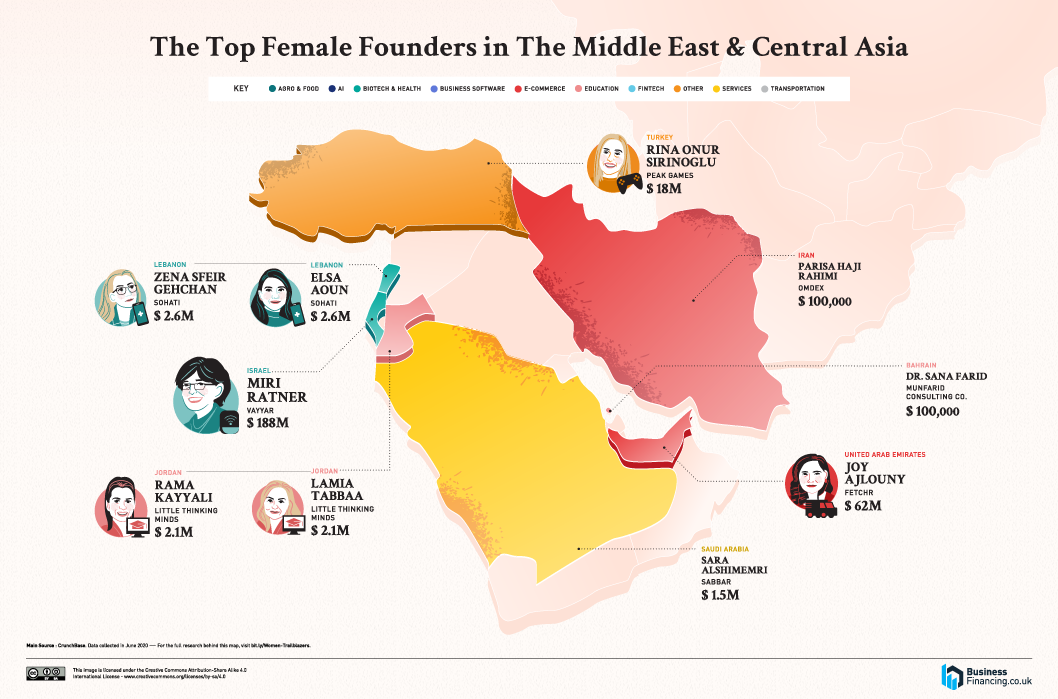
Top Women Founders in the Rest of Asia & Oceania
Of the top ten financial successes in this region, half were in the fields of fintech and e-commerce. As well as frontrunners Lucy Peng (China) and Kate Keenen (Australia), Japan’s Miku Hirano has made great waves with her AI company, Cinnamon. Hirano was inspired to create innovative solutions to improve working culture after the birth of her child. She envisioned how AI assistance in cumbersome tasks could facilitate a healthier future for future generations.
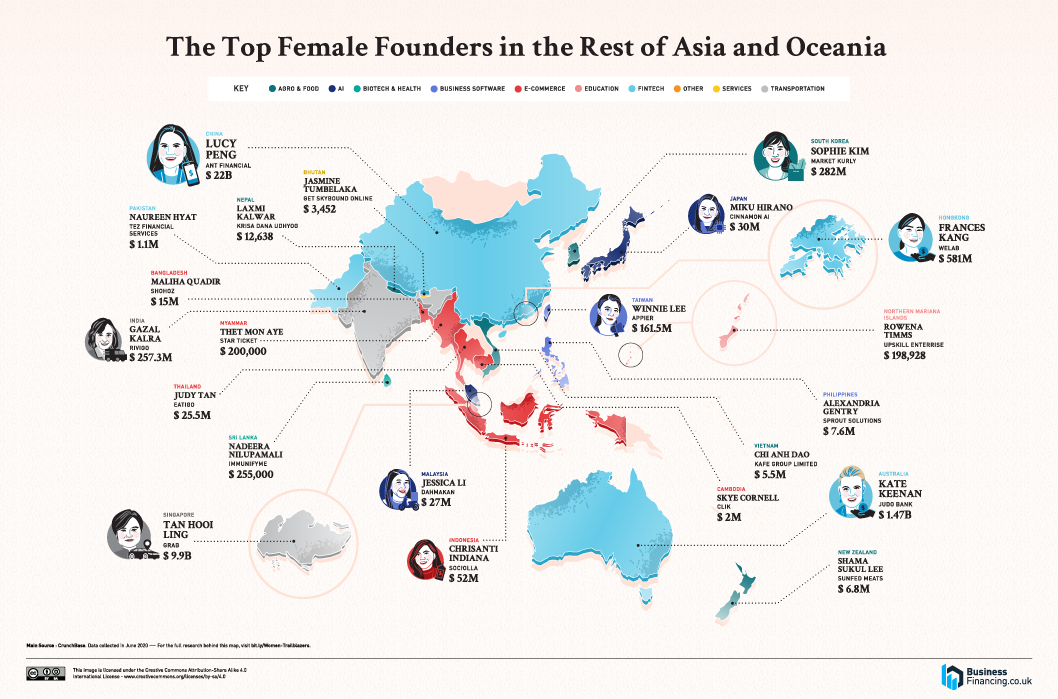
Top Women Founders in Africa
Of the 15 African countries included in the study, women have made strides across a wide range of industries. As well as the usual fintech and e-commerce, various services are focused on helping people in the community access health care, energy, and resources.
Audrey Desiderato has achieved great success, raising $81.3 million for her solar-energy Kenyan company, SunFunder, while Alima Bawah’s Cowtribe made $1.7 million to provide farmers with animal vaccines in Ghana, and Brenda Katwesigye raised $800,000 for WaziVision to provide recycled glasses to people in Uganda.
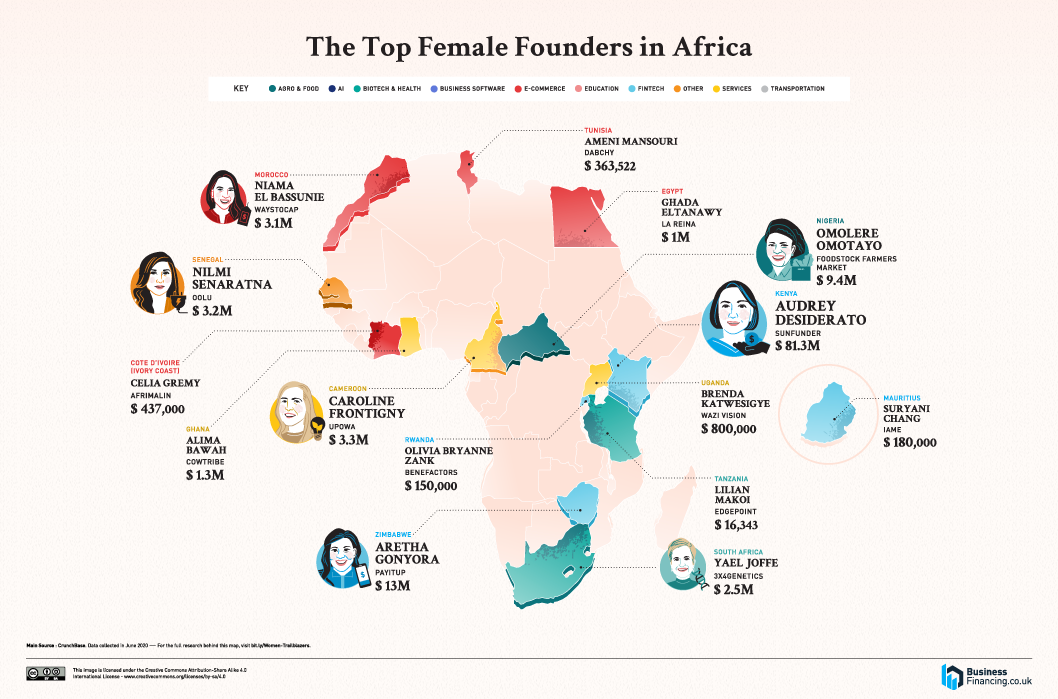
From finance to farming, there’s more to building a successful startup than money. Women entrepreneurs have a talent for seeing how business affects people, and that makes a big difference.
Change Your Mindset
The Silent Skill That Makes People Respect You Instantly
What truly earns respect and why most people go about it the wrong way

Everybody craves respect but not everyone earns it. Some people believe that a title, years of experience, or a position of authority automatically entitles them to respect. (more…)
Entrepreneurs
The Essential Skills Every Entrepreneur Needs In 2026
Success in the digital age isn’t about luck. It’s about mastering the skills that separate dreamers from doers.

When I was 22 years old, I started my first side hustle as a ghostwriter. (more…)
Business
The Hidden Money Pit in Your Operations (and How to Use It)
See how smart asset management software is quietly saving businesses thousands in wasted time, stock, and maintenance.

Trimming unnecessary expenses and minimizing resources is a general practice in running a business effectively. Asset management software can help you achieve those goals. (more…)
Business
Thinking of Buying A Business? These 6 Sectors Quietly Produce the Best Deals
Before you buy your next venture, check out the sectors where successful businesses are changing hands every day.

All entrepreneurs have a desire to be the masters behind a successful venture. Buying an established business is a great choice for many. This provides instant access to an established market with existing infrastructure and clients. (more…)
-

 Did You Know4 weeks ago
Did You Know4 weeks agoThe Success Patterns You Inherited (And Didn’t Notice)
-

 Entrepreneurs3 weeks ago
Entrepreneurs3 weeks agoThe Essential Skills Every Entrepreneur Needs In 2026
-

 Business4 weeks ago
Business4 weeks agoThe Hidden Money Pit in Your Operations (and How to Use It)
-

 Change Your Mindset3 weeks ago
Change Your Mindset3 weeks agoHow to Turn Your Mind Into Your Greatest Asset (Instead of Your Enemy)
-

 Change Your Mindset3 weeks ago
Change Your Mindset3 weeks agoThe Silent Skill That Makes People Respect You Instantly
-

 Life2 weeks ago
Life2 weeks ago10 Research-Backed Steps to Create Real Change This New Year
-

 Tech2 weeks ago
Tech2 weeks agoWhat’s in a Name? How to Get Your Domain Right
-

 Did You Know1 week ago
Did You Know1 week agoHow Skilled Migrants Are Building Successful Careers After Moving Countries
























